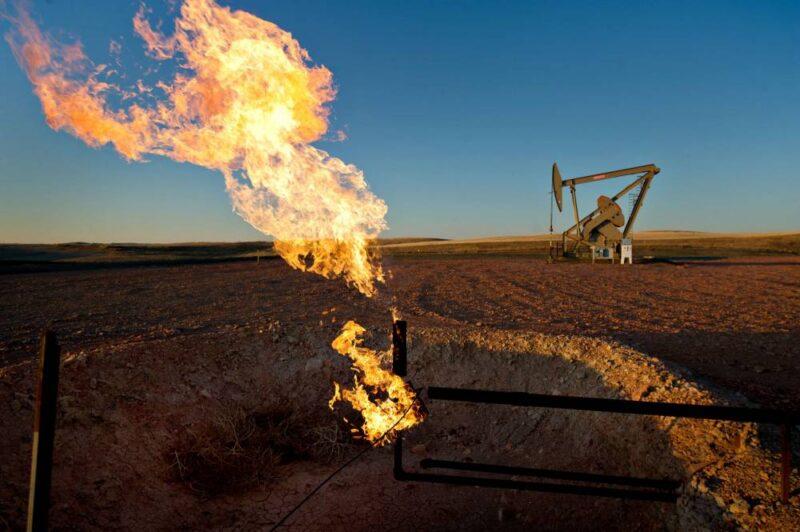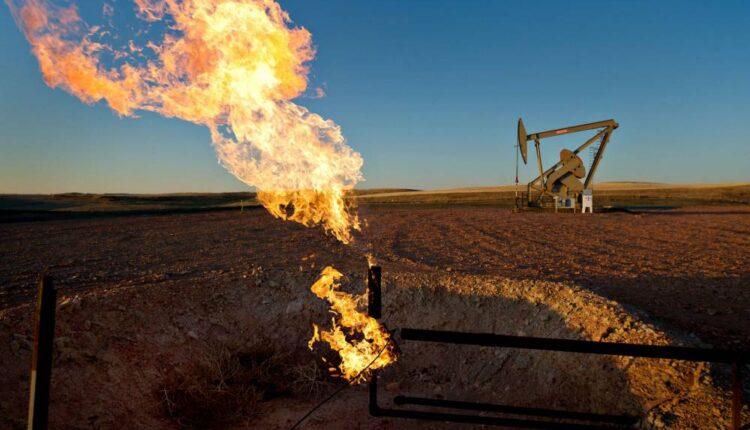
- U.S. oil companies are already paring back spending and closing wells, but wild trading in the futures market was a warning to curb production now because the world at some point will not be able to store any more supply,
- Refineries have already cut fuel production by 25% and could have to do more, as fuel demand has skidded.
- It will be survival of the fittest in the oil patch, with fewer and bigger companies left after a shakeout and consolidation.
- "There are a whole lot of companies that are going to fail, disappear," said one analyst.
Mark II Unitorque electric pumping unit at a crude oil well site outside South Heart, North Dakota.Daniel Acker | Bloomberg | Getty Images
Wild trading in an oil futures contract this week was like an alarm going off for a fire that firefighters already knew was burning.
In this case, the oil industry has been aware that places to store oil are getting scarce because of oversupply, but the crazy trading that sent the May futures contract for West Texas Intermediate crude into a 300% decline Monday (made possible by negative prices), highlighted just how real the problem is.
Simply, holders of the futures contract were unwilling or unable to accept delivery of the physical commodity, and they were forced to pay to get rid of it. In this case, the contract for an oil purchase went negative for the first time ever, and somebody in the market got badly burned.
VIDEO6:3206:32Won't have sustained negative prices because it solves the problem: ProClosing Bell
Steward Glickman, CFRA energy equity analyst, said the May contract, which expires Tuesday, was one thing, but it's the action in the June contract that has now made him expect the oil sector will move faster to shutdown production. The result will be fewer companies left standing after a period of consolidation and bankruptcies.
"The June contract is a different animal. It fell 15% Monday and it fell [again] today. That does speak to concerns over storage. The solution to this is if you are a producer who can't find storage above ground, the next best choice is to find storage below the ground…Just shut it down," he said. The June contract fell sharply Tuesday, to settle down more than 43% at $11.57 per barrel. The contract sold off as investors worried about oversupply and as the USO United States Oil Fund ETF moved some of its funds into the August contract.
The U.S. was producing about 13 million barrels a day before the transportation industry came to a standstill, with a virtual collapse of the airline industry and then a decline in gasoline demand as Americans began to stay home in the second half of March. American drivers are typically responsible for about 10% of global oil demand, and their use of gasoline has been cut in half.
Refiners have already cut back fuel production by 25% or more and they could pull back even more, to where they are producing at just about 60% of capacity. Producers now are under pressure to reduce their output, and the industry is already announcing cuts to cap ex and well closures but will do more.
"We continue to believe energy is in the midst of a generational transition as supply [and] demand adjust to the double black swan on supply and demand," wrote Bank of America analysts. They noted that most large cap U.S. oil companies have made adjustments to get through the downturn and they recommend ExxonMobil, Chevron and ConocoPhillips, all dividend payers.
"I think there's going to be massive cuts. It's already happening. The rig count is down 50% since July. Some of the cuts will be voluntary and will enable companies to live on, and others will be involuntary," said John Kilduff.
But industry experts believe it will be survival of the fittest, and the winners will likely be the bigger companies.
"The industry is more bifurcated so there are healthy companies and unhealthy companies," said Edward Morse, global head of commodities at Citigroup. The healthy companies have already pared back, shut down wells and curbed exploration.
"The first one to shut the lights down is going to be the last one standing," said Morse. "The last to shut the lights is the first to go because companies are looking to preserve cash flow, preserve their balance sheet and reduce expenses until they can re-enter the market. There are a whole lot of companies that are going to fail, disappear."
Glickman said the U.S. industry is so diversified that about 10% of U.S. oil comes from mom and pop drillers, with output of less than 15 barrels a day.
VIDEO7:5807:58Will continue conversations to find available oil storage: Energy Sec.Power Lunch
"Big picture, you've got maybe 140 refineries in this country. You probably have more than 5,000 producers. There's no reason why the industry has to be so fragmented," he said. He said Marathon has shut down two refineries and others could follow.
Glickman said likely buyers for some oil assets could be the larger players or private equity, but it won't happen until the outlook is more clear. "I think there's not a lot of incentive to step in front and buy somebody. It might be easier to wait for more firms to declare Chapter 11 and then pick over" what's left, he said.
Morse said U.S. production is already down about 700,000 barrels a day from its high in February and could be down 1 million barrels by the third quarter. After that, the outlook depends on when the economy reopens, but he thinks demand should pick up and oil prices, based on Brent, will return to $50 by the end of the year.
President Donald Trump has said he would like a rescue plan for the industry but some weak, highly indebted players may still not make it.
"They may be flushed out of the market, rather than get resurrected by capital markets, having available capital to spend on them…I think there's going to be fewer companies, bigger companies and more disciplined companies and then shale can grow again, about 300,000 barrels a day rather than 1 million barrels a day every year, producing twice as much as we were producing five years ago," Morse said. "We have more than 50% less drilling than was going on at the beginning of the year and on fracking, there's two-thirds less than there was at the beginning of the year."
Operationally, it's much cheaper for oil producers to manage existing wells than to continue to open new ones. For frackers, oil output can decline fairly quickly since the biggest production is in the early life of the well and then it wanes quickly.
"This will mean furloughs for oil industry workers, whether it's on the drilling side or the completion side, so I think we're looking at a rough stretch for the industry for sure," said Glickman.
Glickman said there are still some stocks he likes in the sector though investors sifting through them could use a "cast iron stomach."
The S&P energy sector has lost more than half its market cap since the beginning of the year, and at about $633 billion Tuesday was about half of Microsoft's market cap. The industry group includes 27 companies, including Exxon and Chevron.
Glickman said he likes the dividend play of both ExxonMobil and Chevron, and expects both to defend their dividends. He also likes EOG and Conoco, as both are oil have but they have net debt to capital rations that are below 20%, as opposed to the average 35% for exploration and production companies.
–CNBC's Michael Bloom contributed to this story
Source: cnbc.com

